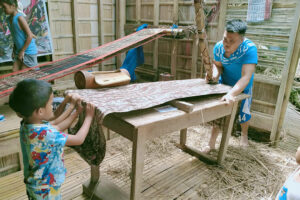Sustainable fashion brands seek to improve transparency, supply chain traceability

By Brontë H. Lacsamana, Reporter
With the popularity of fast fashion and the digitization of the fashion industry, consumers have become more aware about the textile waste, microfiber pollution, and greenhouse gas emissions involved in the mass production of cheap clothing.
Fashion brands that claim to be sustainable are now challenged to be upfront about the socioeconomic and environmental impact of their supply chain processes.
“Consumers feel invested and part of the solution. Sometimes they don’t even question the high prices because they understand the value in a sustainable supply chain and the value it creates for them,” said Joy Anya T. Lim, co-founder and managing director of the Cebu-based social and cultural fashion enterprise ANTHILL Fabric Gallery.
ANTHILL, which stands for Alternative Nest and Trading/Training Hub for Indigenous/Ingenious Little Livelihood seekers, aims to elevating Filipino culture through contemporary and circular design, Ms. Lim said.
“We’ve been asked for the breakdown of our prices and we provide diagrams that illustrate how much goes to our programs, to the artisans, and to overhead costs and margins,” she said at a Nov. 7 panel discussion on sustainable and digital fashion.
Being transparent gives consumers a deep appreciation of the purchase. “For example, we use deadstock or production end cuts, which is textile waste that would otherwise be dumped, sourced from hotels’ discarded linens and towels,” Ms. Lim added.
Sustainable fashion, which can mean many things to different people, is at heart a movement of rethinking humans’ relationship with stuff and consumption.
Susannah Jaffer, founder of Zerrin, an e-commerce platform that supports independent sustainable fashion, said that sellers and brands alike should promote responsible consumption and analyze their supply chain processes.
“At the end of the day, it comes down to doing research and that can feel daunting when you’re used to shopping online and just adding to cart. It has to become more natural to look deeper into the practices of brands and what they say and don’t say,” she said.
In 2021, the European Commission found that up to 42% of green online claims from garments, cosmetics, and household equipment businesses were likely to be exaggerated, false, or deceptive.
Ms. Jaffer added that information such as where a business sources their materials and who makes their clothing can now be obtained. Brands can’t ignore messages anymore because it would hurt their online reputation not to be transparent.
Sustainability in fashion is often a journey as well, according to lifestyle publishing house Indonesian Femina Group president and director Svida Alisjahbana.
“For Jakarta Fashion Week, I’m working with a lot of sustainable designers and I see that many work differently. It can be through circularity, through staying true to heritage and tradition, or through passing on the craftsmanship to the next generation,” she said.
She shared that research and development initiatives on organic practices in communities can be two-pronged — to preserve heritage, but also to understand how to cultivate it so it will make more sense for more people, possibly on an industrial level.




